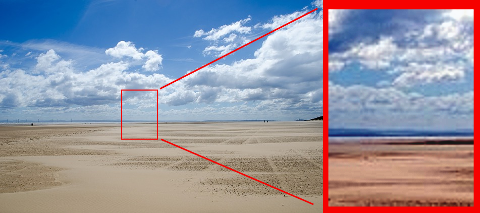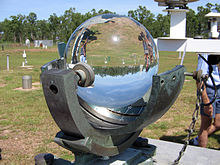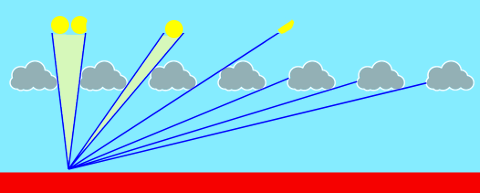I’ve written three articles suggesting how ancient monument could have been used to calibrate a calendar:
But some key data is missing: how often can we see the sun?
Midday sun
There are two separate figures I need. The first is one to work out the probability of seeing an observation when the sun is high in the sky during the middle of the day. The reason this is important, is that if solar observations are being of “the equinox”, then unless it is almost certain the sun can be seen each and every day, then you would build an instrument that could calibrate a calendar with the sun’s position on several days. And the number of sun calibration alignments would increase as the probability of getting a good observation decreased.
So, I simply need to know what is the probability within say an hour of midday of seeing any sunshine. I assume that if you build a massive monument like Stonehenge using 100s or even 100s of people, that it would not be a problem having a person continuously watching the henge waiting for sunshine. So, even a minute’s sunshine would be enough.
This ought to be an easy figure to obtain. This is regularly measured using a Campbell–Stokes recording device and “shining” is recorded by marking of the paper.
Ideally I would like the figure for Salisbury in the UK. But, because I know the UK sees the sun about 30% of the possible time it could, if I had this figure for any location together with the same figure for total sunshine viewing, I could get a rough estimate.
The probability of seeing a sunset or sunrise
As the the above diagram shows, the higher the sun is in the sky, the more direct is the path of the sun’s image to through the cloud layer. So, we can see the sun even when there is a small gap. But as we move toward the horizon, the line of sight to the sun becomes more oblique so that if the gaps were uniform, then toward the horizon we would ahve no view through the clouds.
 However, in the real sky, the clouds are not uniformly distributed, but even so, as the above image shows, the sky can be blue up above but as you move toward the horizon, there is less and less blue sky until at the horizon it is just one mass of grey cloud.
However, in the real sky, the clouds are not uniformly distributed, but even so, as the above image shows, the sky can be blue up above but as you move toward the horizon, there is less and less blue sky until at the horizon it is just one mass of grey cloud.
Unfortunately, this makes it very difficult to estimate the coverage of the sky, because one needs to know both how much of the sky is covered by clouds, but also the vertical extent of the clouds, because tall clouds block more of the sky when viewed obliquely toward the horizon.
 However, there is also another problem. The clouds above us are relatively close perhaps a few thousand feet. But the clouds at the horizon can be as much as 100km away. So, clouds that above us are much bigger than the sun and tend to either block the sun or not, are much smaller when seen at the horizon so that as the picture to the right shows, they tend to only partially block the sun.
However, there is also another problem. The clouds above us are relatively close perhaps a few thousand feet. But the clouds at the horizon can be as much as 100km away. So, clouds that above us are much bigger than the sun and tend to either block the sun or not, are much smaller when seen at the horizon so that as the picture to the right shows, they tend to only partially block the sun.
So, paradoxically, as we move toward the horizon, the area of dense clouds need to be larger and larger to completely block out the sun, suggesting that the probability of seeing the sunset/rise may also go up as well as down toward the horizon.
In other words, it’s not a well defined problem.
Defining the problem
I would appreciate any data. However I suspect someone somewhere is going to have to set up and observation and take photos at sunset. So, what would be a suitable criteria for “being able to see the sun at sunset/rise”.
The key measurement when viewing the sunrise/set for use before modern clocks, is to know the position along the horizon where the sun rose/set. Therefore we need to see:
1. Some part of the bottom of the solar disc and/or the top, in order to know that it has reached the horizon.
2. Some part of either side of the sun’s disk in order to know the position of the sunset.
Whilst in theory any segment of the edge could be used to estimate the sun’s position, I think that given we are dealing with what are supposed to be very accurate observations with the naked eye, we should use a definition that is certain to give a position and that is that either of the extreme left or right points should be visible as well as either the top or bottom points.




You might have noticed I pull data from Chilbolton, is much more available.
Not that far from Stonehenge so the question then is whether enough and the right kind of data available?
I’m not aware of published archives of Met Office data near there.
Tim thanks. That’s useful and I’ve sent an inquiry to Chilbolton so let’s hope they have some data I can churn.
The difficult thing is going to be getting a figure for the probability of seeing a sunset because how many suitable stations are going to be located on a small island with almost 360 degree visibility of the horizon?
The midday figure would be something that I’d usually just go out and take a few measurements myself, but living near Glasgow, I know our weather and particularly the thickness of cloud and is nothing like the south-central England. It’s also something that just cries out to be recorded automatically.